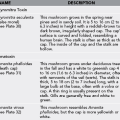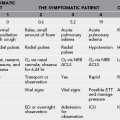Cardiopulmonary Emergencies
Cardiac Emergencies
Acute Coronary Syndromes (Unstable Angina and Acute Myocardial Infarction)
Signs and Symptoms
1. Chest pain that is often described as pressure, heaviness, tightness, or crushing or squeezing sensation and located in the center of the chest. The pain may be poorly localized or of a sharp, stabbing nature. It may radiate into the neck, jaw, or shoulders or down the inner aspect of the arms (left more frequent than right). Sometimes there is only mild chest pain, a burning sensation in the lower chest or upper abdomen, or a feeling of indigestion.
2. Diaphoresis, eructation, nausea, vomiting, anxiety, or dyspnea may be present.
3. Pain is often preceded or exacerbated by physical exertion.
Treatment
1. The patient should discontinue all exertion.
2. Administer oxygen 2 to 4 L/min by nasal cannula if the patient appears cyanotic or has respiratory distress.
3. Administer aspirin 325 mg PO if the patient is not allergic and has no history of significant bleeding.
4. If pain continues and the patient is judged to have normal blood pressure, administer nitroglycerin 0.4 mg sublingually (the patient should be lying down before nitrate administration). If pain persists, repeat this dose every 5 minutes for three doses. Nitrates should be withheld if the patient is suspected of being hypotensive (systolic blood pressure lower than 90 mm Hg). In the absence of a blood pressure cuff, hypotension can be recognized by the inability to palpate a strong radial pulse in the wrist or dorsalis pedis pulse in the foot.
5. If no allergy or bleeding predisposition, give clopidogrel 300 mg PO.
6. Evacuate the patient immediately to the closest medical facility with the patient exerting as little as possible.
7. Notify the emergency department regarding your estimated time of arrival as soon as possible to facilitate their readiness.
Heart Failure
Treatment
1. Keep the patient sitting up, unless he or she is more comfortable lying on his or her back.
2. Administer 100% oxygen by face mask.
3. Administer nitroglycerin sublingually at a dose of 0.4 mg every 5 minutes for three doses (the patient should be lying down before nitrate administration). Nitrates should be withheld if the patient is suspected of being hypotensive (systolic blood pressure lower than 90 mm Hg). In the absence of a blood pressure cuff, hypotension can be recognized by the inability to palpate a strong radial pulse in the wrist or dorsalis pedis pulse in the foot.
4. Give furosemide 20 to 40 mg IV, IM, or PO; if the patient takes daily diuretics, give a dose equal to double the usual daily dose.
5. Treat wheezing with albuterol via a handheld, metered-dose inhaler with a spacer (adult dose 200 to 400 mcg [2 to 8 inhalations, depending on the preparation] q15-20 min prn).
6. Evacuate the patient immediately to the closest medical facility with the patient exerting as little as possible.
Pulmonary Emergencies
Asthma
Signs and Symptoms
4. Prolongation of the expiratory phase of breathing
5. Use of accessory muscles of inspiration (neck muscles are most prominent)
6. In severe cases, wheezing may diminish because the bronchioles become so “tight” that there is not enough air movement to create the abnormal sounds and the patient will appear cyanotic.
Treatment
1. Administer 100% oxygen by face mask.
2. Administer an inhaled bronchodilator, such as albuterol, via a handheld, metered-dose inhaler with a spacer (adult dose 200 to 400 mcg q2-6 h prn).
3. Administer diphenhydramine 50 mg IV, IM, or PO if the attack is associated with an acute allergic reaction.
4. Administer a corticosteroid (prednisone 60 to 100 mg PO for adults and 2 mg/kg/day for children).
5. In severe cases, intubation and assisted ventilation may be necessary.
6. A person with asthma who is in severe distress or who does not have rapid and marked improvement with medication should be transported rapidly to the nearest medical facility.
Pneumonia
Treatment
1. Administer oxygen by nasal cannula to maintain SaO2 greater than 90%.
2. Administer a broad-spectrum antibiotic. Excellent choices include the following:
a. Azithromycin (Zithromax) 500 mg daily for 7 to 10 days (pediatric dose 10 mg/kg first dose, then 5 mg/kg/day for 4 days, with maximum dose 500 mg)
b. Levofloxacin (Levaquin) 750 mg/day for 7 to 10 days (should only be used in children who are skeletally mature: pediatric dose 8 to 10 mg/kg/day, with maximum dose 500 mg)
c. Amoxicillin/clavulanate (Augmentin) 500 to 875 mg bid for 7 to 10 days (pediatric dose 90 mg/kg/day in two divided doses)
d. Erythromycin 250 to 500 mg q6h for 7 to 10 days (pediatric dose 30 to 50 mg/kg/day in four divided doses, with maximum dose 2 g/day)
3. Evacuate any patient with presumed pneumonia who demonstrates profound dehydration, is in sustained respiratory distress, shows signs of hypoxia, or has comorbid illnesses (e.g., diabetes, chronic obstructive pulmonary disease).






